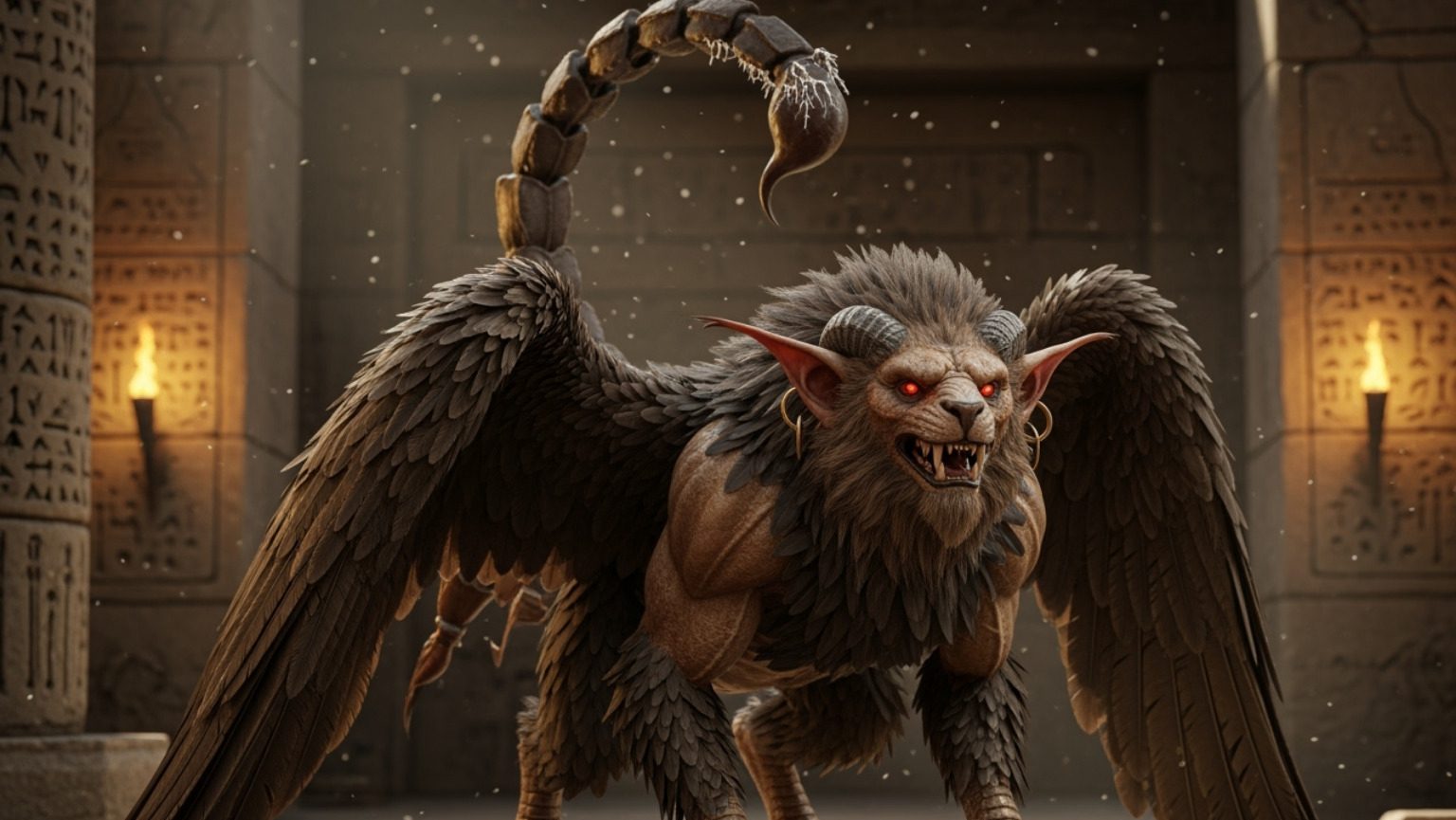
From Ancient Myth to Modern Nightmare
Pazuzu is an ancient Mesopotamian demon who became one of horror cinema’s most terrifying villains in The Exorcist. Originally worshipped as both a destructive force and protective deity in Babylonian and Assyrian cultures from the 8th century BCE, this paradoxical figure has evolved from archaeological artifact to pop culture phenomenon.
Quick Facts About Pazuzu:
- Ancient Role: King of wind demons in Mesopotamian mythology, son of Hanbi
- Physical Description: Hybrid creature with a canine face, taloned hands and feet, a scorpion’s tail, and four wings
- Dual Nature: Both bringer of famine/disease and protector against evil spirits like Lamashtu
- Modern Fame: Primary antagonist in William Peter Blatty’s 1971 novel The Exorcist and 1973 film
- Cultural Impact: Referenced in everything from The Simpsons to recent viral TikTok conspiracies
This ancient demon’s journey from protective amulet to cinematic nightmare reflects our enduring fascination with forces beyond our control. Archaeological evidence shows Pazuzu was invoked by pregnant women seeking protection, yet Hollywood transformed him into pure evil.
The story becomes even more intriguing when you consider how a 15-centimeter bronze statuette found in Nimrud has influenced everything from horror films shot in New York to viral social media trends spreading through the city’s diverse communities.
As R. Couri Hay, I’ve witnessed how ancient symbols like Pazuzu continue to captivate New York’s cultural elite, appearing in gallery exhibitions and inspiring artists across the city. My decades covering the intersection of high culture and popular phenomena have shown me how these timeless archetypes remain surprisingly relevant to today’s sophisticated audiences.
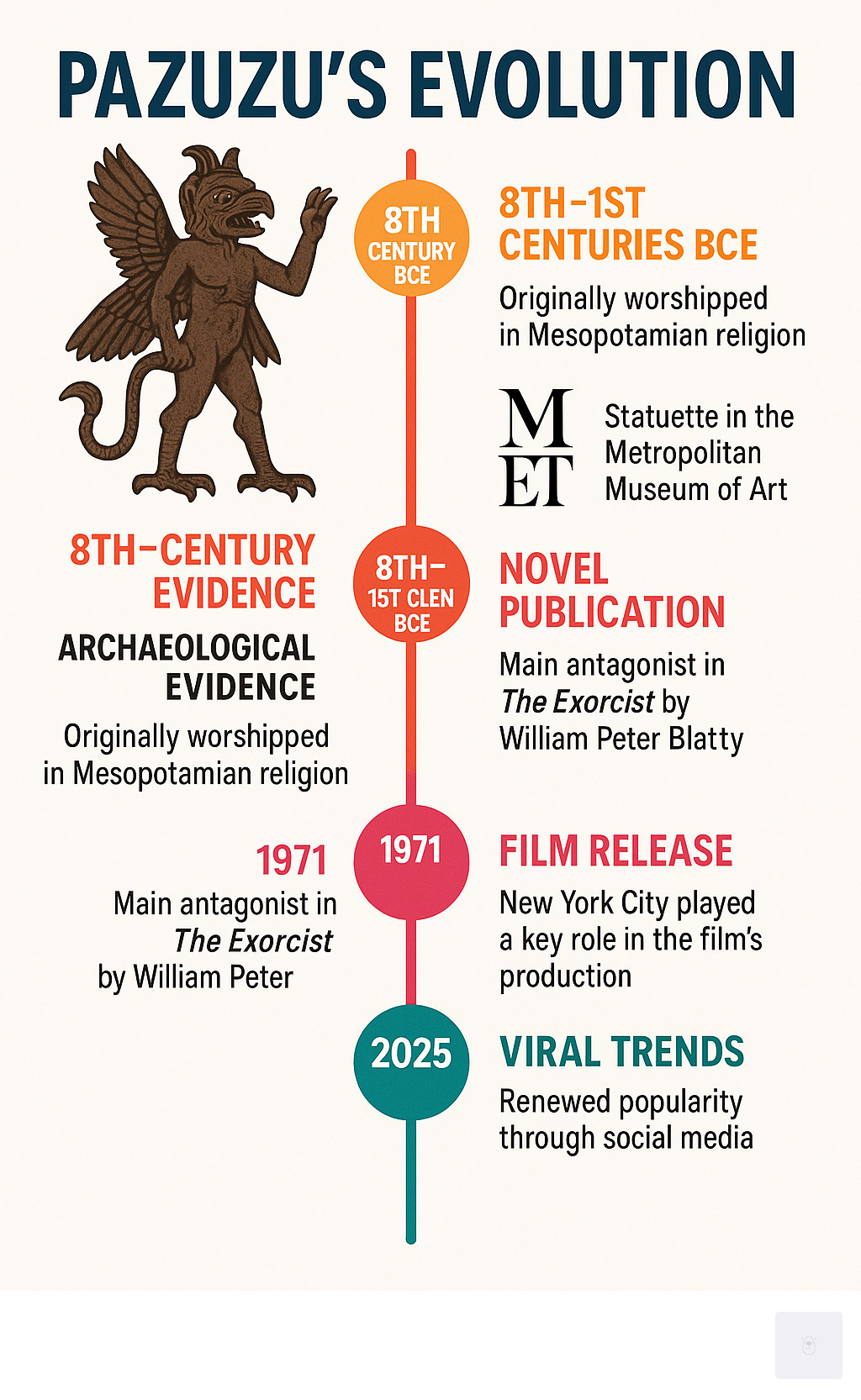
Key terms for Pazuzu:
Unearthing the Mythological Pazuzu
The Origins of a Mesopotamian Demon King
Our journey into Pazuzu begins in ancient Mesopotamia, a land of rich mythology and complex spiritual beliefs. In Assyrian and Babylonian mythology, dating back to the 1st millennium BCE, Pazuzu emerged as a formidable figure. He was known as the King of the Evil Wind Demons, often associated with the dreaded southwest wind—a force that brought with it famine, locusts, and pestilence. Imagine the fear this invoked in ancient peoples, whose lives were so closely tied to the whims of nature!
Archaeological evidence helps us piece together his story. The earliest confirmed findings of Pazuzu date to the 8th century BCE, found in places like Nimrud. These ancient artifacts, often small figurines or amulets, show us how real and present Pazuzu was in the daily lives of Mesopotamians. Written sources describing him also appear from around 670 BCE, and the majority of his representations were found in the 7th and 6th centuries BCE, indicating a period of widespread reverence—or perhaps, widespread apprehension.
According to the lore, Pazuzu was the son of Hanbi, a god associated with evil, and the brother of Humbaba, the fearsome guardian of the Cedar Forest in the Epic of Gilgamesh. This lineage placed him firmly within a pantheon of powerful, often malevolent, entities. Yet, as we’ll find, his role was far more nuanced than simply being a harbinger of doom. For those of us in New York City, it’s fascinating to consider that some of these ancient artifacts, like the bronze statuette from the Louvre, are mirrored in collections like those at the Metropolitan Museum of Art, connecting our modern metropolis directly to this ancient past.
The Paradoxical Protector: Warding Off Evil with Evil
Here’s where Pazuzu gets truly interesting and defies our modern understanding of demons: he was also seen as a protector. Yes, this terrifying wind demon, associated with drought and plague, was simultaneously invoked to ward off other, arguably worse, evils. It’s a classic case of “evil against evil,” a concept that might seem strange to us today but made perfect sense in ancient Mesopotamian spiritual practices.
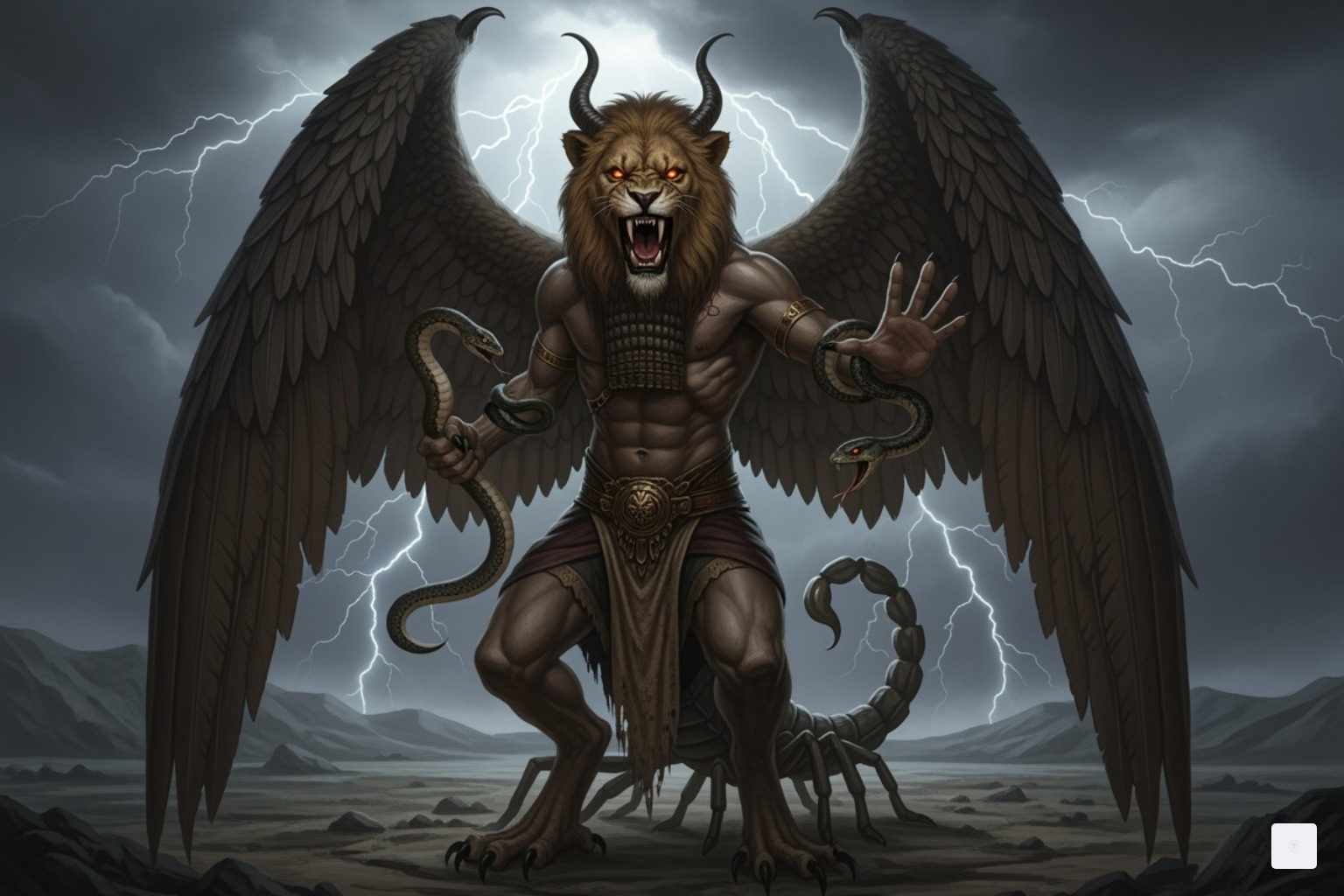
His primary adversary, and the entity he was most commonly invoked to fight, was Lamashtu. Lamashtu was one of the most feared demonesses in Mesopotamian mythology, notorious for attacking pregnant women, stealing babies from the womb or during breastfeeding, and causing infant deaths. Imagine the desperation of a mother in ancient times, fearing for her child’s life. In such a world, even a demon king like Pazuzu could be a source of hope.
Apotropaic magic, which uses objects or rituals to ward off evil, was central to this belief. Amulets and statuettes of Pazuzu were widely popular. Pregnant women wore them, and small full-body figurines were hung across entrances of abandoned houses, presumably as a protective measure. These amulets had to be worn so Pazuzu‘s gaze was always directed outwards, ensuring his formidable energy was aimed at potential threats like Lamashtu. Ritual incantations would accompany the use of these charms, changing Pazuzu from a destructive force into a fierce guardian.
The Distinctive Look of the Demon Pazuzu
When we talk about Pazuzu, we can’t ignore his striking appearance. His iconography is truly unique and immediately recognizable. He’s depicted as a hybrid creature, a terrifying blend of human and animal features that was meant to instill fear in other malevolent entities.
Our research tells us that Pazuzu‘s physical form includes:
- A leonine or canine face with bulging eyes and a gaping mouth.
- A scaled, human-like torso and arms (most surviving figures show human hands rather than taloned claws).
- Two pairs of wings, symbolizing his dominion over the winds.
- Taloned feet that resemble those of an eagle.
- A scorpion’s tail curling upward behind him.
- Additional serpentine features that emphasized his fearsome nature.
He is typically shown with his right hand pointing upwards and his left hand downwards, a pose that perhaps symbolizes his control over both the upper and lower fields—or his ability to bring both good and ill. What’s truly remarkable about Pazuzu‘s imagery is that it appeared suddenly and fully realized in the archaeological record, with no apparent evolutionary stages. It’s as if this complex, terrifying figure simply sprang into existence in the ancient mind, a fully formed visual representation of a powerful force.
These distinctive features made Pazuzu amulets and figurines instantly identifiable. For those of us living in New York, we can appreciate the artistry and cultural significance of these artifacts firsthand. For example, the Metropolitan Museum of Art in New York City houses notable artifacts, including a Pendant with the head of Pazuzu, allowing us to connect directly with the ancient world and marvel at this demon king’s enduring visual legacy.
From Ancient Artifact to Horror Icon: The Role of Pazuzu in The Exorcist
William Peter Blatty’s Terrifying Creation
Most of us didn’t first meet Pazuzu in a dusty archaeology textbook. Instead, we encountered this ancient demon through the spine-chilling pages of William Peter Blatty’s 1971 novel The Exorcist and its legendary 1973 film adaptation. This is where Pazuzu truly earned his place as one of horror’s greatest villains.
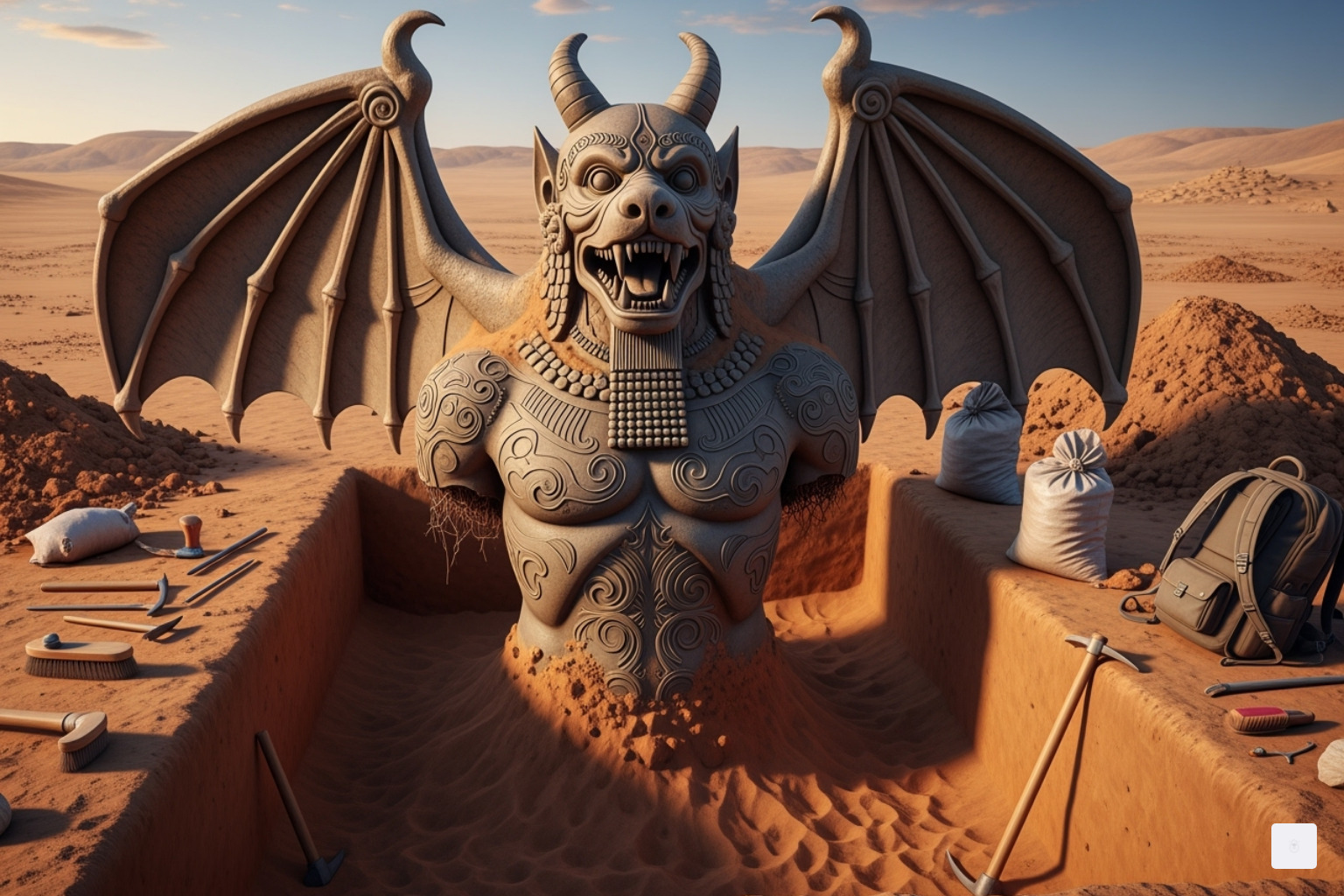
Blatty’s genius lay in taking this relatively obscure Mesopotamian entity and changing him into the ultimate cinematic nightmare. Unlike his ancient role as a protective force, Pazuzu became purely malevolent in The Exorcist—a terrifying presence that possesses young Regan MacNeil and torments her family.
The story behind the story is equally fascinating. Blatty drew inspiration from a real-life case of alleged possession that occurred in 1949, involving a 14-year-old boy known as “Robbie Mannheim” (or Roland Doe). This true account, combined with Blatty’s deep exploration of faith and evil, created a narrative that would haunt audiences for generations.
In the film’s opening scene, Father Merrin finds a giant demonic statue during an archaeological dig. That imposing figure? It’s Pazuzu himself. Though the demon’s name appears only in the script (where he lies to Father Karras, claiming to be Satan), this visual clue immediately establishes the ancient, formidable nature of the evil Merrin must face.
The film’s impact on New York City’s horror scene was tremendous. Local theaters became gathering places for terrified audiences, and the movie sparked countless conversations about good, evil, and the supernatural across the city’s diverse communities. The Exorcist didn’t just frighten us—it made us think deeply about forces beyond our understanding.
Behind the Screams: Portraying a Cinematic Demon
Creating Pazuzu‘s terrifying presence on screen required extraordinary dedication from the cast and crew. The results were as controversial as they were effective.
The demon’s chilling voice came primarily from Mercedes McCambridge, though she went uncredited for years. Her commitment was legendary and slightly disturbing. McCambridge consumed raw eggs, chain-smoked cigarettes, and drank whiskey to achieve that gravelly, otherworldly sound that still gives us nightmares. During recording sessions, she was even bound to a chair to help reach the desired “crazed state of mind.”
The gross-out effects were equally inventive. When Regan projectile vomits, that’s actually McCambridge regurgitating a mixture of chewed apple and raw egg. The sound of the demon finally leaving Regan’s body? That unsettling audio came from pigs being herded for slaughter—a subtle reference to a New Testament story.
While Linda Blair delivered most of Regan’s possessed performance, actress Eileen Dietz served as a body double for the more extreme physical scenes. Those shocking subliminal flashes of the white-faced demon throughout the film were actually rejected makeup tests, cleverly recycled to amplify the psychological terror.
The demon’s makeup design drew inspiration from a mask in the 1964 Japanese horror film Onibaba, adding another layer of cultural influence to Pazuzu‘s cinematic change.
Production wasn’t without drama. Disputes arose over credit for the voice work and body double performances, adding real-world controversy to the fictional horror. Yet these behind-the-scenes struggles only improved the film’s mystique.
The Exorcist remains a landmark in New York’s film history. It showcased the creative spirit that thrives in our city—pushing boundaries, taking risks, and leaving lasting impressions on audiences worldwide. The film proved that ancient demons could find new life in modern storytelling, turning Pazuzu from archaeological curiosity into cultural phenomenon.
The Enduring Legacy: Pazuzu’s Footprint in Modern Culture
Beyond The Exorcist: A Pop Culture Phenomenon
Here’s something that might surprise you: even if you’ve never seen The Exorcist, you’ve probably encountered Pazuzu somewhere. This ancient demon has become one of pop culture’s most recognizable figures, showing up in the most unexpected places across our entertainment landscape.
Pazuzu‘s grotesque yet strangely compelling image has transcended horror, becoming a cultural touchstone that creators love to reference. You’ll spot him in comedy parodies on Saturday Night Live and Scary Movie 2, proving that even ancient demons aren’t immune to getting roasted. The animated world has accepted him too – The Simpsons featured him in their “Treehouse of Horror” episodes, including a memorable appearance in Season 29 that aired on October 22, 2017.
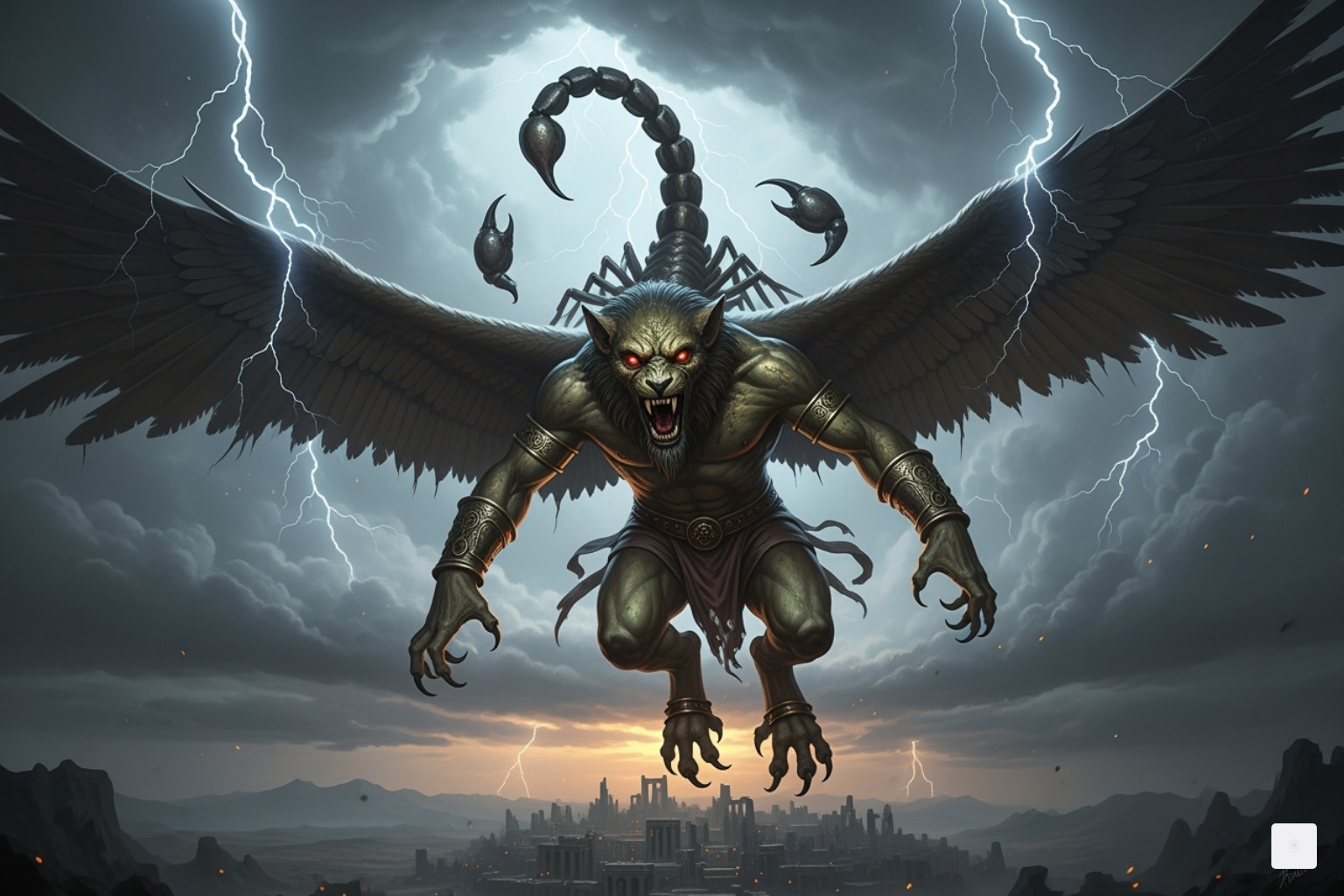
The demon’s influence stretches remarkably wide. Television series from Highlander and Once Upon a Time to supernatural hits like Constantine and Supernatural have all nodded to his legacy. In The Exorcist television series, Pazuzu even returns under the clever alias ‘The Salesman’ – a fitting name for someone who trades in terror.
Music and gaming have welcomed him too. The Gorillaz featured him in their surreal music videos, while gamers can actually face him as the final boss in The Exorcist: Legion VR. Fantasy enthusiasts know him from Dungeons & Dragons lore, where he rules as a powerful demon lord commanding six Balors and hundreds of vrocks from Pazunia, the first layer of the Abyss.
Perhaps most unexpectedly, professional wrestling has felt his influence. Wrestler Danhausen bases his distinctive face makeup on Pazuzu, while Beyond Wrestling features a top heel faction called Team Pazuzu. From high art galleries to wrestling rings, this ancient figure continues to inspire New York’s diverse creative communities in ways the original Mesopotamians could never have imagined.
The Labubu Doll Controversy: When Ancient Demons Go Viral
Sometimes truth really is stranger than fiction. Recently, Pazuzu found himself at the center of a viral conspiracy theory that would make even seasoned New Yorkers shake their heads in disbelief. The unlikely culprit? Adorable fuzzy dolls called Labubu.
These cute collectibles, created by Hong Kong artist Kasing Lung for Chinese company Pop Mart, became an unexpected lightning rod for supernatural paranoia. Labubu dolls, part of ‘The Monsters family’ series, feature mischievous expressions and nine distinctive pointy teeth. They’re meant to be playful and endearing – hardly the stuff of demonic possession.
But social media had other plans. A conspiracy theory began spreading online, particularly across platforms popular with younger users. Someone created a cartoon comparison showing Pazuzu alongside a Labubu doll, focusing on those pointy teeth as “evidence” of a sinister connection. The theory gained such momentum that genuinely frightened doll owners began burning their Labubu collections and posting videos of the destruction online.
The irony here is almost too perfect. As we’ve learned, Pazuzu was often invoked as a protector in ancient times. Meanwhile, Pop Mart describes Labubu as “a kind-hearted character despite its mischievous appearance.” Kasing Lung has clearly stated his inspiration came from ancient European elf legends, not Mesopotamian demons.
This bizarre episode perfectly captures our digital age’s ability to transform innocent objects into sources of fear through viral misinformation. It also shows how quickly such trends can spread through interconnected communities – from online forums to coffee shops across New York City, where conversations about everything from ancient mythology to toy collecting happen daily.
The whole saga serves as a reminder that even in our sophisticated modern world, the power of ancient symbols like Pazuzu continues to captivate and sometimes terrify us in the most unexpected ways.
Frequently Asked Questions about Pazuzu
Was Pazuzu a real demon?
This question comes up constantly, and honestly, it’s more complex than you might think. Pazuzu wasn’t just some Hollywood invention—he was absolutely considered a real supernatural entity by the ancient Babylonians and Assyrians throughout the first millennium BCE. To them, he wasn’t fictional at all, but a powerful force within their daily spiritual reality.
Think about it this way: Pazuzu was the personification of that dreaded southwestern wind that brought very real consequences—famine, locusts, drought. Ancient peoples didn’t have meteorology to explain these devastating weather patterns, so they understood them through figures like Pazuzu. He explained the unexplainable and gave them a way to potentially protect themselves through ritual and prayer.
For those of us here in New York City, we might encounter Pazuzu‘s image in our world-class museums or on movie screens. But for ancient Mesopotamians, he was as real as the wind itself—an unseen but tangible presence that shaped their world. In that cultural context, Pazuzu was absolutely real, just not in the way we might define reality today.
Is Pazuzu considered evil or good?
Here’s where Pazuzu becomes truly fascinating—he completely defies our modern understanding of good versus evil. This ancient demon king embodies what I find to be one of the most intriguing paradoxes in mythology.
On one hand, Pazuzu was undeniably malevolent. He brought the devastating southwest winds, drought, and plague. Ancient texts describe him as “reprehensible” and “fearsome.” He was the king of evil wind demons, after all. But here’s the twist that makes him so compelling: he was also a fierce protector.
The concept was “evil against evil.” Pazuzu was regularly invoked to fight off Lamashtu, that terrifying demoness who attacked pregnant women and murdered infants. Imagine being a desperate mother in ancient times—you’d absolutely want this powerful demon on your side, even if he was frightening himself.
His grotesque appearance wasn’t just for show—it was meant to scare away other malevolent spirits. Ancient Mesopotamians understood that sometimes you need a monster to fight a monster. This nuanced approach to good and evil reflects the sophisticated spiritual thinking of these ancient cultures.
Living in New York’s incredibly diverse cultural environment, we see how different communities interpret morality and protection. Pazuzu stands as a perfect example of how ancient peoples steered these complex spiritual territories, recognizing that the world isn’t always black and white.
Why was Pazuzu chosen for The Exorcist?
William Peter Blatty’s decision to feature Pazuzu in The Exorcist was absolutely brilliant from a storytelling perspective. As someone who’s covered New York’s entertainment scene for decades, I can appreciate the genius behind this choice.
First, Pazuzu brought instant authenticity to the horror. This wasn’t some made-up movie monster—he was a genuine ancient entity with thousands of years of terrifying reputation behind him. When audiences saw that imposing statue during the archaeological dig scene, they were looking at something rooted in real historical fear.
The timing was eerily perfect too. Archaeological evidence of Pazuzu had been found in Nimrud, and a statue identical to the one in the film was found in 1971—the exact same year Blatty published his novel. That kind of coincidence adds an unsettling layer to the whole story.
Pazuzu‘s mythological background was perfect for possession themes. He had genuine historical connections to supernatural afflictions, disease, and spiritual torment. This wasn’t just random—ancient peoples actually believed he could influence and inhabit human experience.
From a visual standpoint, Pazuzu‘s distinctive appearance—those eagle talons, the scorpion tail, the four wings—provided incredible imagery for the film. Even though we only catch glimpses, his presence looms over the entire story.
Perhaps most cleverly, Blatty adapted Pazuzu for pure horror by stripping away his protective aspects. While ancient peoples saw him as a complex figure who could ward off greater evils, the film presented him as relentless, uncompromising malevolence. This change amplified the terror while maintaining the historical gravitas that made the story feel disturbingly real.
The choice resonated powerfully with New York audiences and viewers worldwide, cementing Pazuzu‘s change from ancient protector to modern nightmare—a testament to the enduring power of well-chosen mythological source material.
Conclusion: The Timeless Allure of an Ancient Demon
What a journey we’ve taken together—from the windswept deserts of ancient Mesopotamia to the busy galleries of New York’s Metropolitan Museum of Art. The story of Pazuzu is truly remarkable, showing us how a single mythological figure can capture human imagination across thousands of years.
Pazuzu, once a Babylonian amulet, became a terrifying Hollywood villain and now sparks TikTok conspiracies. In New York, this demon king inspires art and debate, showing how ancient symbols like Pazuzu evolve to reflect our complex fears.
Pazuzu’s 3,000-year journey—from protector to horror icon to meme—reveals our need to reshape stories. His enduring presence in New York’s creative scene, from the Met to coffee shops, proves Pazuzu’s timeless lesson: narratives that confront the unknown last forever.
More info about our branding services

